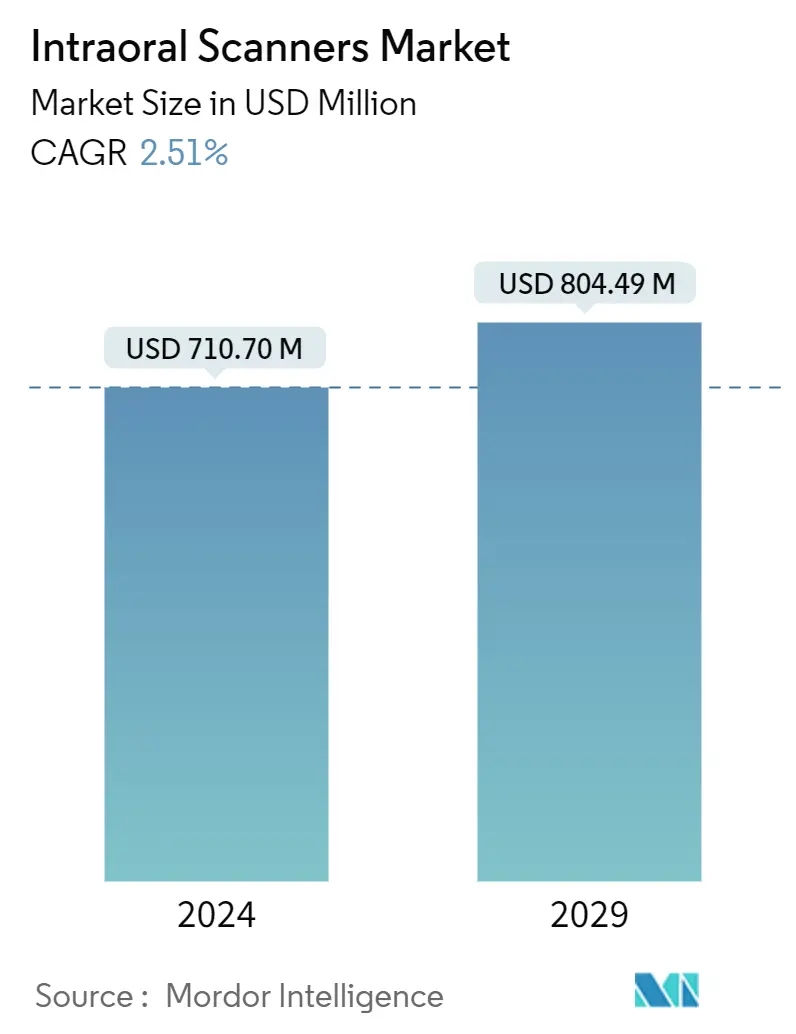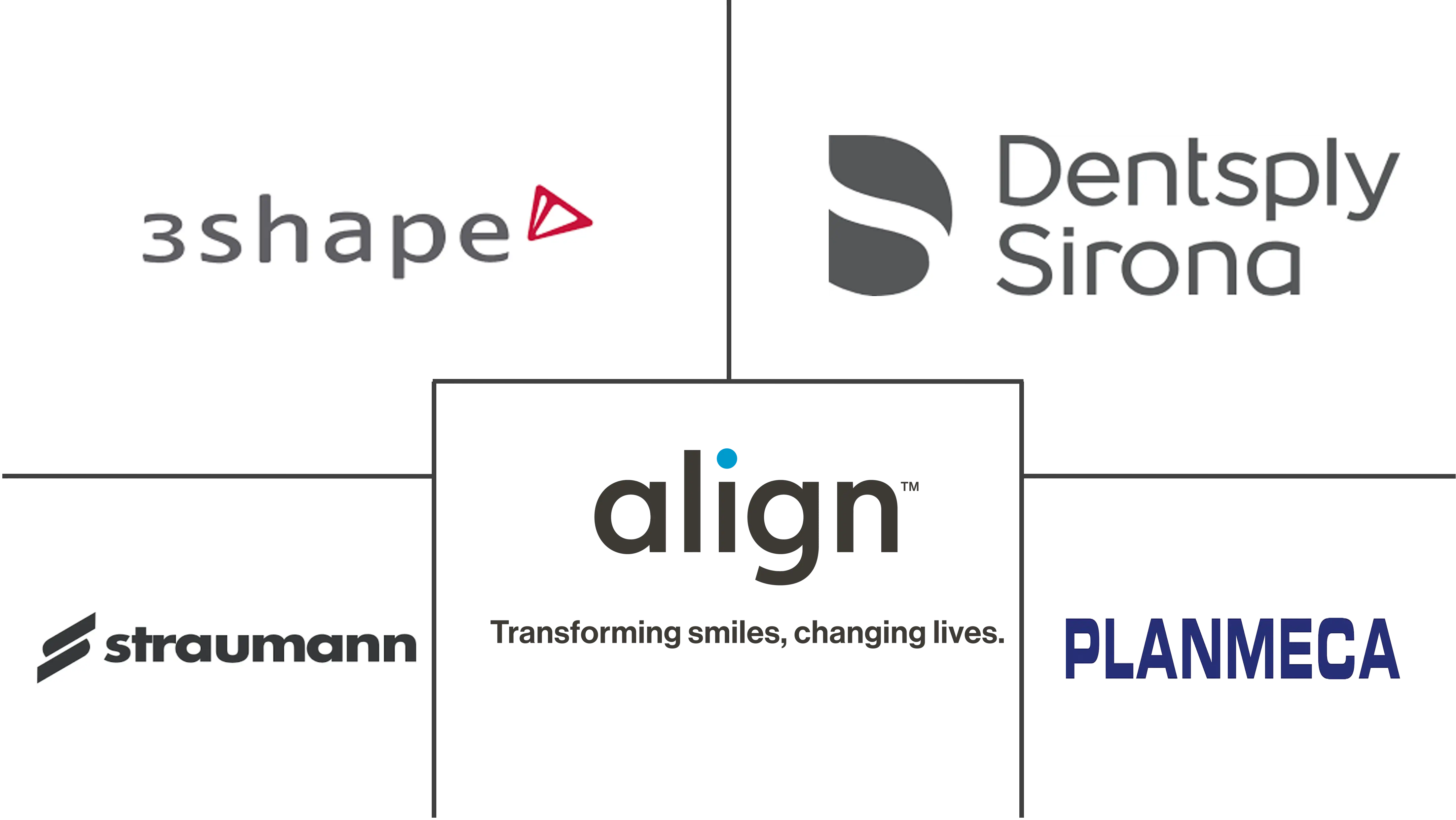Market Size of Intraoral Scanners Industry

| Study Period | 2021- 2029 |
| Market Size (2024) | USD 710.70 Million |
| Market Size (2029) | USD 804.49 Million |
| CAGR (2024 - 2029) | 2.51 % |
| Fastest Growing Market | Asia-Pacific |
| Largest Market | North America |
| Market Concentration | High |
Major Players
*Disclaimer: Major Players sorted in no particular order |
Intraoral Scanners Market Analysis
The Intraoral Scanners Market size is estimated at USD 710.70 million in 2024, and is expected to reach USD 804.49 million by 2029, growing at a CAGR of 2.51% during the forecast period (2024-2029).
The COVID-19 pandemic contributed largely to transforming the growth of intraoral scanners markets. Initially, the outbreak of COVID-19 showed a substantial effect on the intraoral scanner market because patients' visits to dental clinics and hospitals were significantly reduced due to the global social distancing and lockdown measures taken by governments. During the initial phase of the pandemic, the American Dental Association (ADA) published recommendations for dental emergency and non-emergency care. Apart from conditions involving acute pain, infection, or trauma, the removal of teeth not showing any symptoms, and restorative dentistry, which includes the treatment of asymptomatic carious lesions and cosmetic dental procedures, all were considered non-emergencies by the American Dental Association (ADA).
However, during the COVID-19 pandemic, tooth fractures, dental treatment cementation, pericoronitis, etc., were identified as emergency dental procedures. Hence, it was observed that the COVID-19 pandemic had a significant impact on the market studied. However, currently, the market has reached pre-pandemic in terms of demand for the intraoral scanner.
Additionally, the significant factors responsible for the growth of the intraoral scanner market include an increase in the geriatric population, a rise in dental disorders, and technological advancements. For instance, the high prevalence of dental caries due to unhealthy eating and lack of oral care among populations in various countries is the key factor driving the market’s growth. For instance, as per the National Dental Epidemiology Program survey of 5-year-old children in England in 2022, the national prevalence of children with enamel and dentinal decay was 29.3%. As per the same source, regionally, this ranged from 23.3% in the Southwest to 38.7% in Northwest England. The introduction of intraoral scanners in the dental devices market has modernized the dental practice landscape. These have eliminated the limitations of taking tooth impressions and helped dentists instantly transfer and manipulate data. Thus, such features are likely to increase the adoption of intraoral scanners across healthcare facilities, thereby contributing to market growth.
The increasing geriatric population is expected to facilitate market growth as the elderly population is prone to developing dental disorders because of salivary changes related to aging, consumption of a poor diet, and exposure to dental roots due to gingival recession. For instance, according to the report published by the World Economic Forum in September 2023, more than 1 in 10 people in Japan are aged 80 or over in 2023. In addition, the National Institute of Population and Social Security Research projected that those aged 65 or older will account for 34.8% of the total population in 2040. Thus a positive correlation between the senior population and an increase in incidences of tooth loss and other dental-related disorders is expected to positively impact the market growth.
Thus, factors such as rising dental disease prevalence owing to the rising geriatric population, product launches, and approvals over the forecast period are likely to facilitate market growth. However, the lack of skilled professionals in developing economies such as India and China and the high cost of intraoral scanners may restrain market growth.
Intraoral Scanners Industry Segmentation
As per the scope of the report, intraoral scanners are digital devices used to capture 3-dimensional images of the internal area of the mouth. The device provides details of soft tissues in the intraoral area through superior-quality images. Intraoral scanners generate videos or capture images, coupled with the fabrication of virtual copies of the intraoral site.
The intraoral scanner market is segmented by modality (standalone and portable), end user (dental clinics, hospitals, and other end users), and geography (North America, Europe, Asia-Pacific, the Middle East and Africa, and South America). The report also covers the estimated market sizes and trends for 17 countries across major regions globally.
The report offers the value (in USD) for the above segments.
| Modality | |
| Standalone | |
| Portable |
| End User | |
| Dental Clinics | |
| Hospitals | |
| Other End Users |
| Geography | ||||||||
| ||||||||
| ||||||||
| ||||||||
| ||||||||
|
Intraoral Scanners Market Size Summary
The intraoral scanners market is poised for steady growth over the forecast period, driven by several key factors. The market has rebounded to pre-pandemic levels after experiencing a significant impact due to COVID-19, which initially reduced patient visits to dental clinics. The resurgence in demand is attributed to the increasing prevalence of dental disorders, particularly among the aging population, and technological advancements in dental devices. Intraoral scanners have revolutionized dental practices by eliminating the limitations of traditional tooth impressions, allowing for instant data transfer and manipulation. This technological shift is expected to enhance the adoption of intraoral scanners across healthcare facilities, contributing to market expansion. The growing geriatric population, prone to dental issues due to age-related changes and dietary factors, further supports market growth, as does the rising incidence of dental caries and other oral health conditions.
The market landscape is characterized by competitive dynamics, with major players like 3Shape AS, Align Technology Inc., Dentsply Sirona Inc., and PLANMECA OY leading the charge. These companies are actively engaging in strategic initiatives such as acquisitions, partnerships, and new product launches to strengthen their market positions. The introduction of advanced scanners, such as the wireless TRIOS 5 and the Ori Intraoral Scanner, highlights the ongoing innovation in the sector. Additionally, favorable reimbursement policies and government support initiatives, particularly in regions like North America, are expected to further drive market growth. As intraoral scanners continue to gain traction in the dental impression market, their role in digital dentistry is set to expand, offering improved precision, patient comfort, and overall quality of dental care.
Intraoral Scanners Market Size - Table of Contents
-
1. MARKET DYNAMICS
-
1.1 Market Overview
-
1.2 Market Drivers
-
1.2.1 Rapid Technological Advancements
-
1.2.2 Increase in Geriatric Population
-
1.2.3 Rise in Dental Disorders
-
-
1.3 Market Restraints
-
1.3.1 Lack of Skilled Professionals
-
1.3.2 High Cost of Intraoral Scanners
-
-
1.4 Porter's Five Forces Analysis
-
1.4.1 Bargaining Power of Suppliers
-
1.4.2 Bargaining Power of Buyers/Consumers
-
1.4.3 Threat of New Entrants
-
1.4.4 Threat of Substitute Products
-
1.4.5 Intensity of Competitive Rivalry
-
-
-
2. MARKET SEGMENTATION
-
2.1 Modality
-
2.1.1 Standalone
-
2.1.2 Portable
-
-
2.2 End User
-
2.2.1 Dental Clinics
-
2.2.2 Hospitals
-
2.2.3 Other End Users
-
-
2.3 Geography
-
2.3.1 North America
-
2.3.1.1 United States
-
2.3.1.2 Canada
-
2.3.1.3 Mexico
-
-
2.3.2 Europe
-
2.3.2.1 Germany
-
2.3.2.2 United Kingdom
-
2.3.2.3 France
-
2.3.2.4 Italy
-
2.3.2.5 Spain
-
2.3.2.6 Rest of Europe
-
-
2.3.3 Asia-Pacific
-
2.3.3.1 China
-
2.3.3.2 Japan
-
2.3.3.3 India
-
2.3.3.4 Australia
-
2.3.3.5 South Korea
-
2.3.3.6 Rest of Asia-Pacific
-
-
2.3.4 Middle East and Africa
-
2.3.4.1 GCC
-
2.3.4.2 South Africa
-
2.3.4.3 Rest of Middle East and Africa
-
-
2.3.5 South America
-
2.3.5.1 Brazil
-
2.3.5.2 Argentina
-
2.3.5.3 Rest of South America
-
-
-
Intraoral Scanners Market Size FAQs
How big is the Intraoral Scanners Market?
The Intraoral Scanners Market size is expected to reach USD 710.70 million in 2024 and grow at a CAGR of 2.51% to reach USD 804.49 million by 2029.
What is the current Intraoral Scanners Market size?
In 2024, the Intraoral Scanners Market size is expected to reach USD 710.70 million.

